What is Gross Living Area (GLA) and How Do You Calculate It?
Knowing how to calculate the Gross Living Area (GLA) of a property is an important part of creating the appraisal report and estimating the value of a home. This article walks you through the steps on how to calculate GLA with confidence.
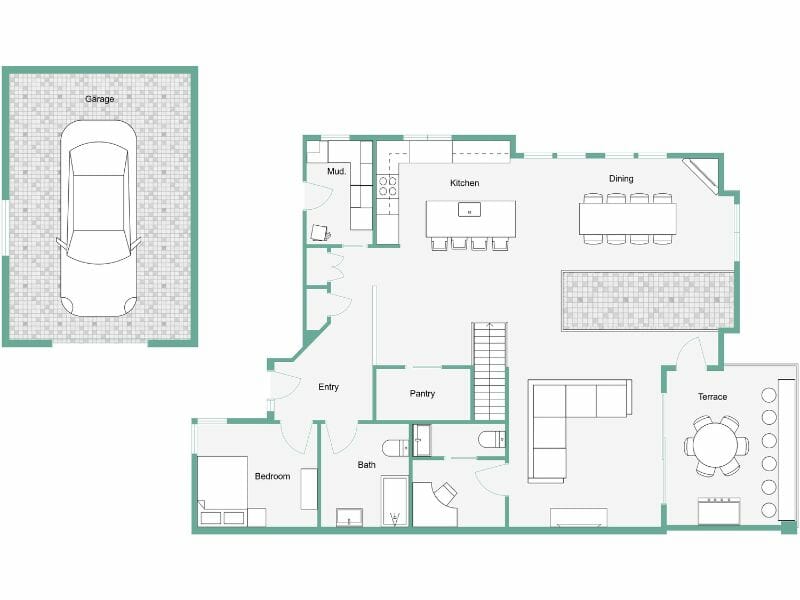
What is Gross Living Area (GLA)?
Real estate is measured after local regulations worldwide. In the US, Gross Living Area (GLA) is defined by the Appraisal Institute’s Dictionary of Real Estate Appraisal, 7th Ed., as the total area of finished, above-grade (above the ground) residential space. It is calculated by measuring the outside perimeter of the structure and includes only finished, habitable, above-grade living space. Finished basements and attic areas are not generally included in the GLA total. However, local practices differ on this.
GLA is a critical part of the valuation of a home or property. It is not the same as total living area (TLA). Although the Appraisal Institute does not strictly define TLA, it is typically taken to include any finished basement space, livable attic areas, and even unattached accessory dwelling units.
Why is it Important to Know the Exact GLA of a Home?
The livable, above-ground space in a residential property is the part of the home that commands the greatest price. The valuation of the property is often a direct result of how much of the property’s space has this condition and will, in turn, directly impact insurance costs and value and, ultimately sales price.
Because of this, it’s important that the appraiser include every valid area in a GLA calculation so that the property achieves its rightful sales price, the mortgage lender knows the correct value, and the property is properly insured.
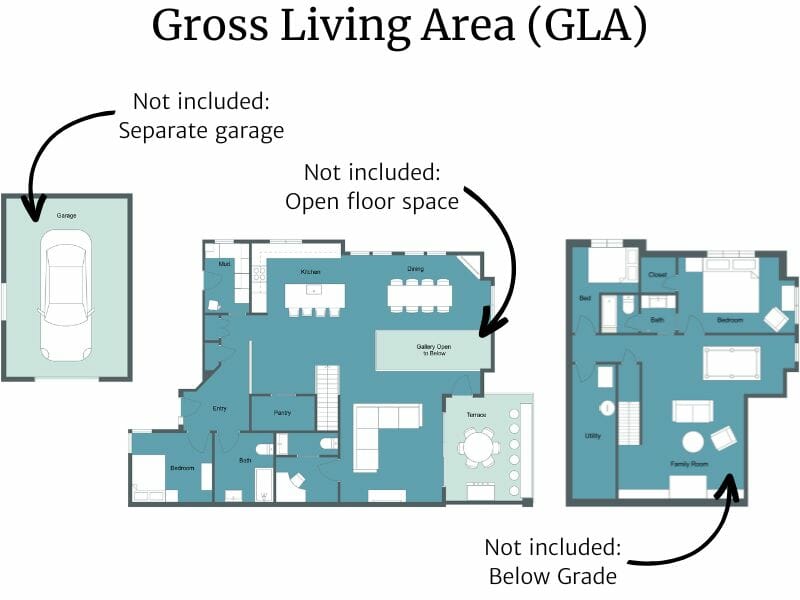
How is Gross Living Area Measured and Calculated?
Historically, GLA has been open to interpretation in how it was calculated, with appraisers, remodelers, and the like using different definitions and calculations. In the United States, the American National Standards Institute (ANSI) recently introduced ANSI Z765-2021 to document common standards for appraisers.
Some organizations, such as Fannie Mae, a leading source of mortgage financing in the United States, now require appraisers to use these standards and provide a helpful overview document.
The ANSI home measurement standard has a few key elements:
- It applies to single-family housing. It doesn’t apply to apartments, condos, or commercial property.
- It defines Gross Living Area (GLA) and what to include or exclude from the calculation.
- Measurements are noted to the nearest inch or tenth of a foot and reported on a sketch or floor plan of the property. The final square footage calculation is to be reported to the nearest whole square foot.
What Is Included in the GLA Calculation?
For a space to be included as GLA, it must adhere to these six criteria:
- It must be finished. It must contain walls, floors, and ceilings, finished with standard materials such as carpet, drywall, etc.
- It must be above ground. Even a space just 2 ft below ground counts as basement space and is omitted.
- It has to be enclosed. It must have four walls.
- It needs to be contiguous. It must be connected to the rest of the Gross Living Area.
- It must be conventionally heated, using forced air, solar, radiant heating, etc. (space heaters do not count)
- It must be permitted. The local city or county building department must have permitted the area.
If an area meets all these elements, include it in the GLA. Note that the external walls for included areas are part of the measurement. A space is excluded from the GLA if any of the above criteria are unmet. Instead, it can be noted as a separate line item in the report and included as part of the TLA.
What Are Non-GLA Areas in a Property?
As the GLA is the total of the above-ground residential space of contiguous, finished areas, it is important to understand which areas of a property are not included in the GLA calculation. These areas are, however, often included in the calculation of TLA.
Examples of areas that are not included in the GLA calculation are:
- Unfinished garages.
- Below-grade (below ground level) rooms such as basements. This includes walk-out basements - ones with direct access to the outside - typically found in a home built on a slope. Instead, list them in the TLA.
- Finished outbuildings or structures not connected to the main building, such as cottages or Accessory Dwelling Units (ADU). Instead, list them in the TLA.
- Finished areas that are only connected to the main living space by an unfinished area - in other words, they are not connected by a finished and heated corridor or staircase. For example, a guest suite attached to the main home via an unfinished garage. Instead, list them in the TLA.
- Finished living spaces where more than half of the ceiling area is less than 7-foot-high. If the ceiling slopes (such as in an attic), any area with less than a 5-foot ceiling height must be excluded from the GLA.
- Covered or uncovered patios and decks.
- Porches that are not enclosed, or if enclosed, are not suitable for year-round use. These are often called three-season rooms.
- Openings in a level that look down to the floor below, such as a vestibule or foyer.
- Bump-outs that do not have a floor. For example, a cantilevered window-seat bump-out.
- A fireplace is excluded if it is surrounded on three sides by external walls.
- A room that was constructed or remodeled without an appropriate permit.
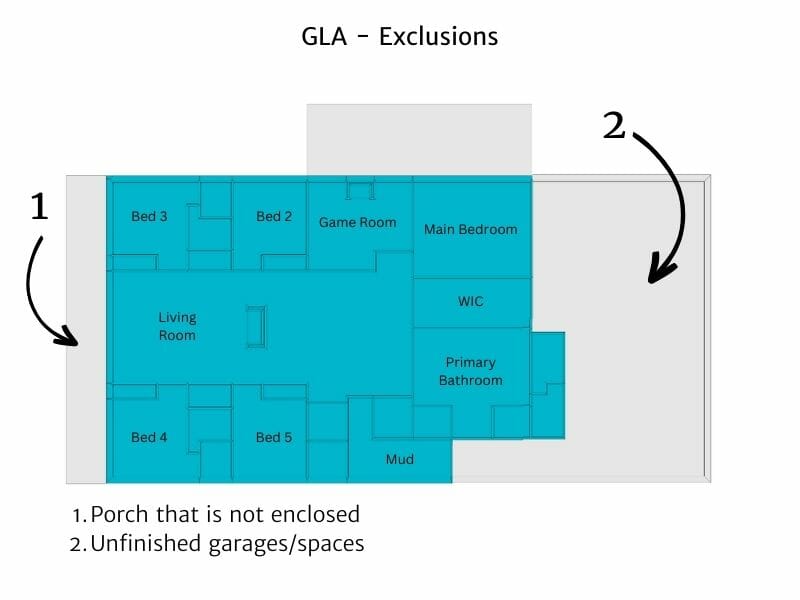
5 Practical Tips on How to Measure GLA On-Site
- Start with a walkaround - Walk around the outside of the home or property to get an idea of the shape of the property.
- Sketch on paper or tablet - Make a quick sketch of the property shape on paper or create a digital sketch using floor plan software on your tablet.
- Start measuring - work your way from corner to corner and use a tape measure, roto wheel, or a laser to get the correct measurements. Round your measurements to the nearest inch or the nearest 1/10th of a foot so you comply with the ANSI standard.
- Head inside - Make sure to go inside the property and measure any areas that don’t meet GLA standards. These areas should be listed as TLA.
- Do the math - Add together all the areas that comply with GLA requirements - this is the GLA. Then add up the areas that are non-GLA, and add these to your GLA area, which gives you your TLA.
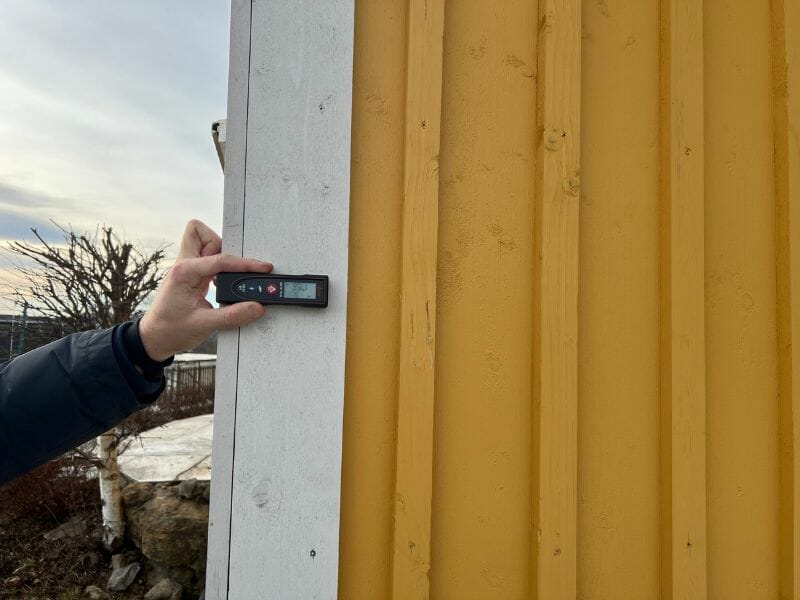
Bonus Tip! Use Software to Double-Check Your Calculation
Make a professional floor plan sketch complete with measurements and annotations, and add this as part of your appraisal report. This gives complete transparency on how you came to your calculation and gives you the confidence you have arrived at the right number.
Pick floor plan software like RoomSketcher, as here you get an in-built total area calculator that you can use to double-check your measurements. If everything matches up, then great! If your GLA and the RoomSketcher GLA are way off - you should go back to the property to double-check your measurements.
GLA vs. Total Living Area (TLA)
While GLA is the finished, connected, above-ground space in a residential property, Total Living Area (TLA) typically includes below-ground finished space and non-connected (or non-contiguous) space.
Total Living Area includes, for example, finished basement space and separate finished buildings such as cottages and accessory dwelling units. Additionally, heated, finished attic spaces would be included as long as more than half the area has a ceiling height of seven feet or more. In the case of a slanted ceiling in the attic, only the area with a height of five feet or more is counted.
If you use floor plan software like RoomSketcher to draw your professional floor plan, you can set up any space to exclude, so the automatic calculation doesn’t include this area.

GLA vs. Gross Building Area (GBA)
Whilst GLA is the standard for single-family homes, multi-family residential properties with two to four units are often measured using Gross Building Area (GBA). Both GLA and GBA calculate the finished areas of a building.
The main difference is that below-grade living space is included in the Gross Building Area. Like GLA, GBA includes finished hallways, storage rooms, laundry rooms, and interior stairways.

GLA vs. Gross Internal Area (GIA)
Gross Internal Area (GIA) is often used for commercial buildings. The Gross Internal area (GIA) is the entire enclosed internal floor space, measured to the inside face of the exterior walls.
This measurement can give commercial building leases an idea of the usable interior floor area. The measurement includes any space used by internal walls or partitions, as well as hallways, restrooms, and storage rooms. It may also include garages and basements.
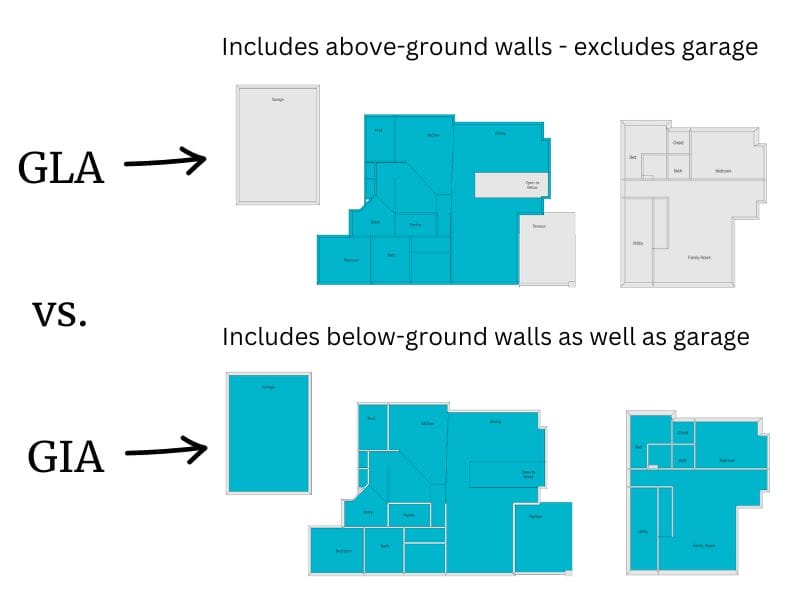
GLA vs. Total Square Footage
There is no “official” definition of total square footage. Rather total square footage is used to describe the square footage of a specified area. You could, for example, report the total square footage of the garage, which would not indicate whether the garage was finished or contiguous with the home.
The GLA only includes above-grade, finished, contiguous areas of a home whilst the total square footage includes other areas (that may not be living spaces) as long as they have walls, ceilings, and floors.
Total Square Footage can include garages, workshops, unfinished storage areas, porches, patios - any area under the main roof, as well as detached structures like separate garages, guest suites, or cabanas.

GLA vs. TLA vs. GBA vs. GIA
Still confused? Check out this handy table to give you a quick reference as to what is what:
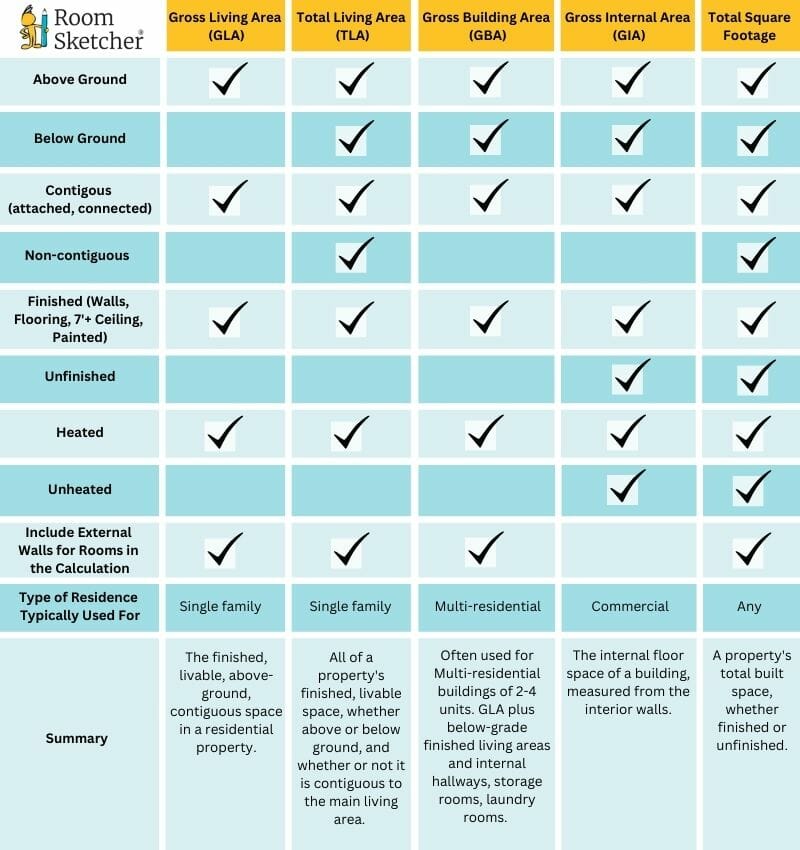
Frequently Asked Questions (FAQ):
Mostly. A GLA calculation includes the external walls for the rooms, areas, and staircase, which meet the GLA standard, so only the exterior walls of those areas are included.
No, unless it has been permitted and converted into an above-grade, contiguous, finished, heated, livable space.
Generally, yes, if they meet the height requirements.
The stair treads and landing areas are considered part of the room from which they descend, so if that room is considered part of GLA, so is the stair area. If the stair opening is larger than the stairs, then only the stairs (treads and landings) are included in the GLA for the floor from which the stairs descend.
The stair tread and landings are included in the Gross Living Area for the level from which they descend. For example, stairs descending from a 2nd level to the ground floor are counted in the GLA of the 2nd level.
Any area beneath the staircase is included in the square footage of the floor to which the stairs descend. So the area beneath the staircase in our example is included in the GLA for the ground floor.
Note that if the opening to a stairwell is the same size as the stairs, then the entire opening is part of the GLA for the floor from which the stairs descend. If the opening is wider than the stairwell, then include only the area equal to the size of the stairs (in the GLA for the floor from which the stairs descend).
If a fireplace is surrounded on three sides by external walls, it is not part of GLA.
Finished attics are common in many areas. According to the definition of GLA from the Appraisal Institute, attics are not generally included in the GLA. However, local practices on this differ. In many areas, an attic’s area can be included in the GLA as long as it is heated and finished.
If there is a sloped ceiling in the attic, then the ANSI Z765-2021 standard states that you can only include the floor area where the ceiling measures five feet up. Furthermore, at least one-half of the finished floor area must have seven feet of ceiling height.
Take Your Appraisals to the Next Level
Appraising is an important job requiring accuracy and attention to detail. There are generally recognized measurement guidelines depending on the area in which you live. Some of the guidelines now require computer-generated sketches for appraisal reports.
If you want an easy way to turn your hand-drawn sketches into professional floor plans, check out RoomSketcher. If you want to discuss our services or ask questions about Gross Living Area calculations, please contact us; we would love to help you.
Don't forget to share this post!
Recommended Reads
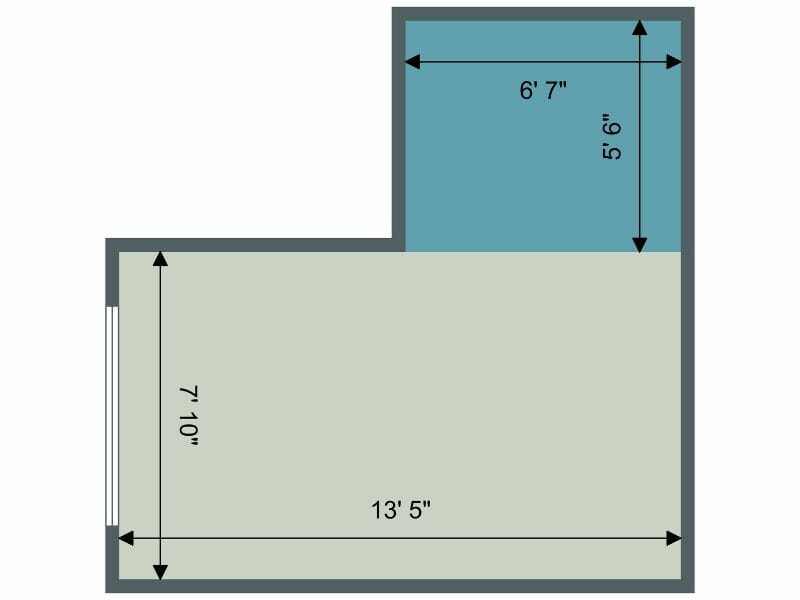
How to Measure Floor Area
Measure floor areas easily, quickly, and accurately. The correct results are essential for ordering materials for renovation projects, preparing sales and marketing materials for a property, and designing the furniture layout.
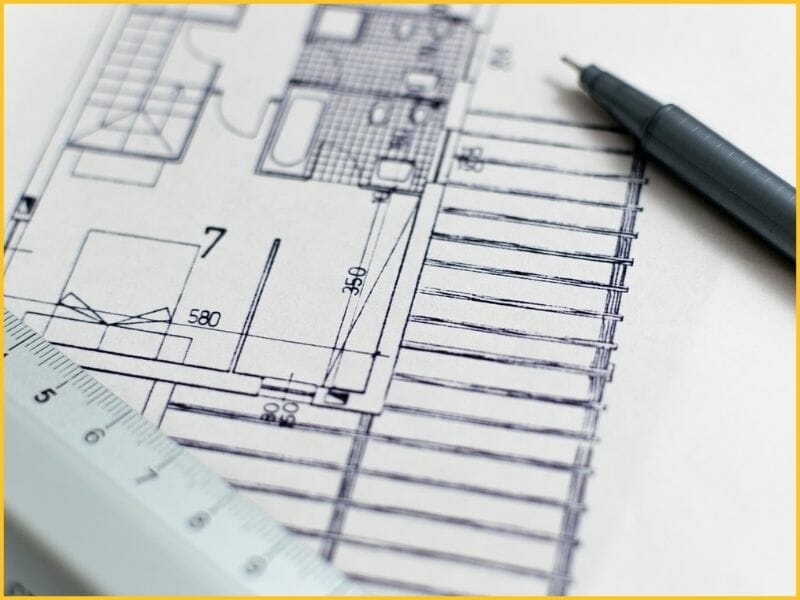
How Much Does a Floor Plan Cost?
Wondering about floor plan cost? We help you understand price differences between floor plans from architects, draftsmen, and software.
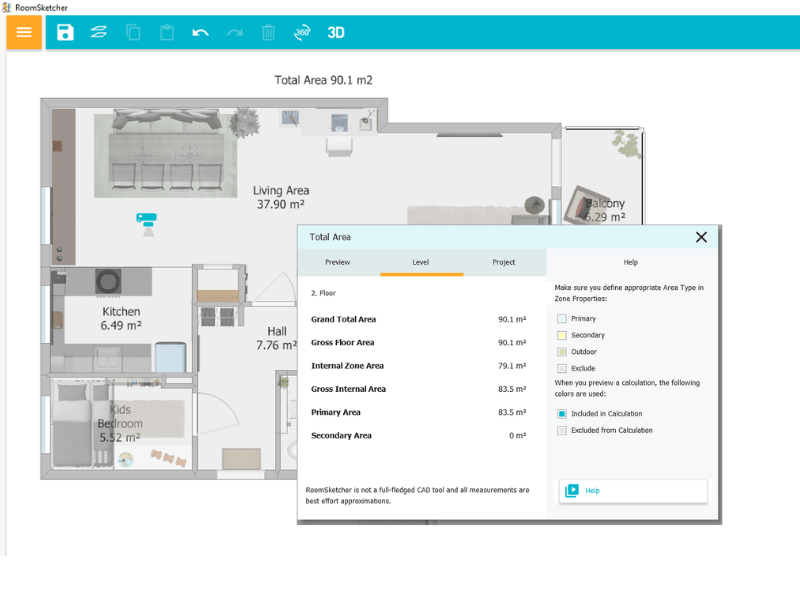
Powerful Floor Plan Area Calculator
Need to calculate the total area of your floor plan? No problem! RoomSketcher automatically calculates your floor plan area with our all new Total Area feature.
